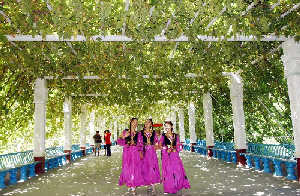|
Turpan
( 2005-09-13 )
 'The Lowest' 'The Lowest'
 The Turpan Basin is China's lowest point. With an area of more than 4,000 square kilometers, the basin is actually under the sea level, with more than half of the area being 100 meters under the sea level. The basin slopes from the north to the south. The lowest area in the basin is Aiding Lake, located 155 meters below sea level -- the second-lowest place in the world after the Dead Sea. The Turpan Basin is China's lowest point. With an area of more than 4,000 square kilometers, the basin is actually under the sea level, with more than half of the area being 100 meters under the sea level. The basin slopes from the north to the south. The lowest area in the basin is Aiding Lake, located 155 meters below sea level -- the second-lowest place in the world after the Dead Sea.
The bottom of the Aiding Lake is flat with shallow waters. The lakebed is 40 kilometers long from east to west and 8 kilometers wide from north to south. The water is only 1 meter deep at its deepest point. The lake now occupies a much smaller area than before, with bitter saltwater remaining only in the western part. The water's mineral content is as high as 200 grams per liter. As a result of strong evaporation for many years, niter (potassium nitrate) and salt mines have collected at the bottom of the lake.
 'The Sweetest' 'The Sweetest'
The Turpan Basin is also known for producing some of the sweetest fruit in the country. Geologically, a blocked basin, rare cloud formations, and high temperatures are considered unique if they all appear in the same place. And Turpan is endowed with all of these factors, which, in turn, produce abundant thermal energy. This natural condition has furnished the region with a top environment for agriculture and gardening.
Statistics show that there are more than 300 clear days in Turpan, with only one to three days with 80-percent cloud coverage. Also, Turpan is frost-free for an average 268 days per year.
Since the seedless grapes produced in Turpan are said to be the sweetest in the world, Turpan is called the "sweetest place" by friends from around the planet. Since the 1960s, 300 new strains of grapes have been introduced from abroad for trial planting, substantially enriching the basin's grape variety.
|

